TABLE OF CONTENTS
Does cannabis pot size affect plant growth? You bet it does! Container size makes all the difference for a good weed harvest.
The right size container is the first step toward successful cannabis plant growth that thrive and flourish. Pot sizes vary greatly and are important to get right when growing weed.
Whether you are growing one plant at home, or thousands of cannabis plants in a warehouse or outdoors, cannabis pot sizes make a big difference in the outcome of your yield.
Cannabis plants need proper room to grow in order to get the most out of them.
But how do you determine the right size pots for marijuana growing? What are the advantages of one pot size over another?
How many cannabis plants do you plan to grow in containers? Do you plan to use a grow tent? Will you grow cannabis indoors or outside? What marijuana strain will you grow? How much available space do you have for your cannabis grow containers?
Don’t worry and read on! Take advantage of this article to learn how to choose the best grow containers for your cannabis plant needs. It is imperative to get pot sizes right when growing cannabis.
Cannabis Root Needs
First, let’s talk about what a pot is meant to protect—the roots.
During the germination of a marijuana plant, the first thing that emerges from cannabis seeds is the plant’s central tap root. As the cannabis plant grows, roots and tiny hairs branch off of the central root.
A healthy marijuana plant will develop an underground structure that’s similar to the structure of the branches that are above ground.
Although you don’t see your cannabis plant’s roots, they require just as much care and consideration as the leaves and flowers. Cannabis plants breathe and absorb the nutrients they need through healthy root systems. They are fed through the cannabis roots.
So what do cannabis roots need to make plants thrive? Primarily, room for the plants to grow, proper draining, and no competition for nutrients. Growing cannabis can be easy if you make sure to check off all the right boxes, including the size of the pot.
Room To Grow
More than anything else, marijuana plant roots need enough space to grow properly in their environment. This is especially true in the vegetative stage of growth.
Root growth in the vegetative state is directly related to the plant’s ability to manage water and nutrients in the flowering phase.
If the container doesn’t have enough room, the cannabis roots become tangled together. This is known as “root bound” (or sometimes “pot bound”).
In pot bound plants, root development and growth is inhibited. If that happens, your marijuana plants won’t get the nutrients they need.
This can lead to nutrient deficiencies and lower yields. Make sure they have enough room if you want big yields for your cannabis plant and the cannabis roots are happy!
That said, there’s such a thing as too much room. If your marijuana plant is in a larger pot than it needs, your soil will stay wet. If you soak your plant, they are susceptible to root rot.
Good Drainage
To support healthy roots in cannabis plants your soil should stay a little wet. It should never be soaked. Make sure your soil dries between each watering. It should retain just enough to keep moist and not be completely dry.
No overwatering! Waterlogged soil, excess water, and moisture can eventually cause root disease. Cannabis pots need good draining to keep dry. Get rid of most of the moisture when growing cannabis.
Avoid containers unless they’re designed specifically for growing plants. A Solo cup might seem like a cheap solution, but when your crop fails and your plants die because of runoff water, you’ll see that isn’t the case! And although a pottery bowl is pretty, it won’t look so great when it’s holding a dead shrub covered with pests!
Pots designed for growing have drainage holes in the bottom to manage water. Containers that are fabric pots or plastic pots that have holes everywhere are even better. You don’t want to waste time drilling holes in pots that weren’t designed for plants!
Place large trays or saucers under the pot to collect any excess water that drains out after watering. Some people use a matching saucer or trays that match the size of the pot. The shapes aren’t an issue as long as you ensure that you catch the water runoff!
If it’s not impossible, install a drainage system so that your plants never sit in stagnant water. If you can’t setup a drain, empty the runoff water from the saucers after each watering. You don’t want excess moisture in your weed garden from water runoff when growing cannabis! Plant pot the right way!
No Competition
Never put more than one weed plant in the same pot, no matter what size it is. Each cannabis plant should be contained in its own pot. If more plants are in a pot, the cannabis roots compete for the nutrients you pour in the pot. With this method, none of them will reach their full potential.
There’s another good reason to set a limit of one per container. If trouble occurs in one container (for example, build-up of toxic nutrient levels), you’ll only lose one plant. Plant pot in it's own pot!
What Cannabis Pot Size Should I Use?
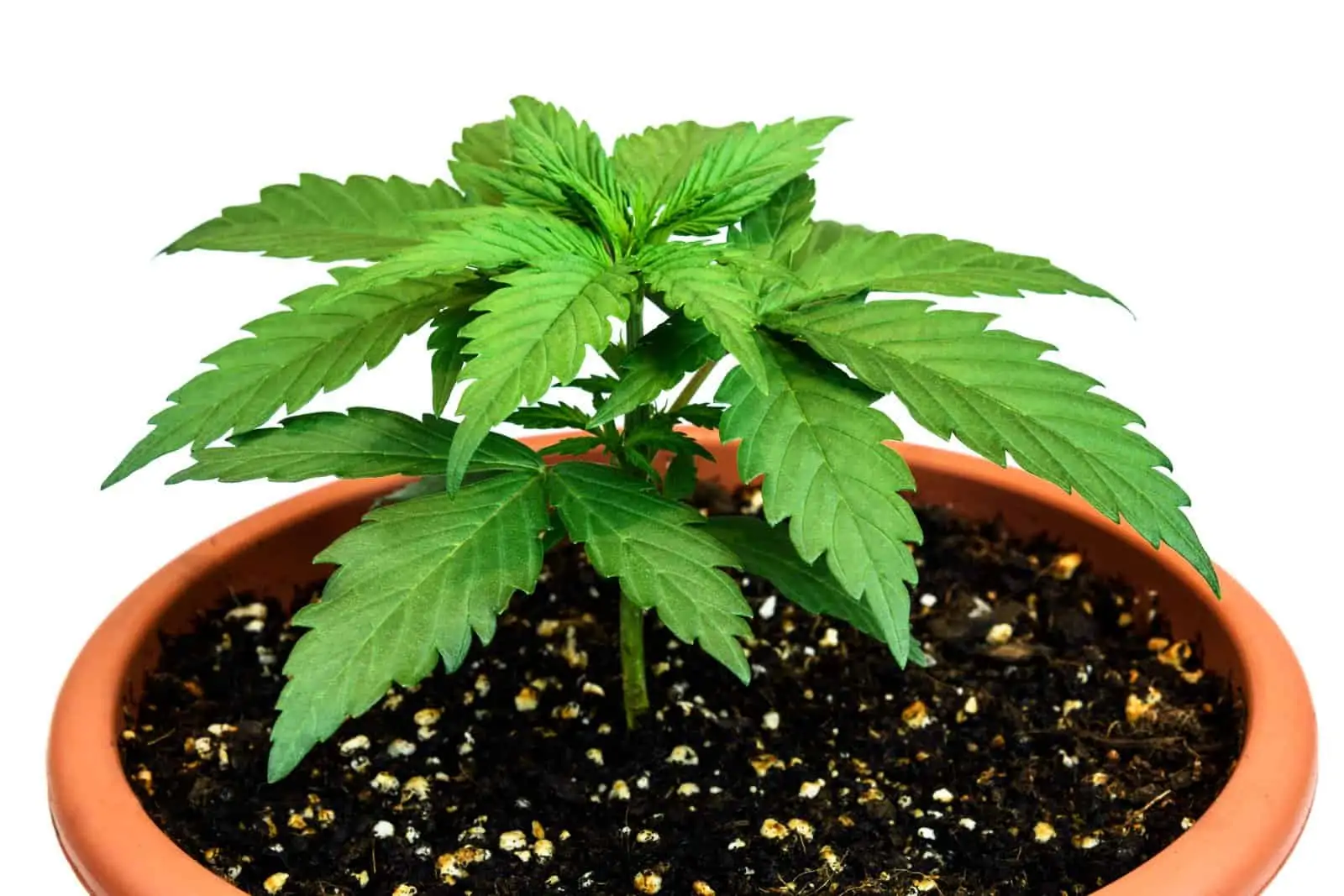
Now that you understand what cannabis roots need, you can see why pot size is so important! But what pot size is best for growing weed? Your marijuana plant will live in two or three separate containers during its life. You’ll use different pot sizes (in gallons or liters) each time you plant pot.
Seedling Phase
One thing to remember is to start small with seedlings when you plant pot. They need large amounts of pampering to begin the best way. During the early stages of growth, sow your cannabis seeds in a seed starter kit designed for baby plants.
Most starter kits for cannabis seeds have an insert with several small cells. Put your cannabis seeds in one cell each. The kits also have a humidity dome with an air vent and a tray at the bottom to collect excess water.
You can’t go wrong by purchasing a pack of 5 or 10 trays at the Amazon market place website. It won’t cost much money. Put it in your cart for less than $10.
Don’t forget the importance of the right media for your cannabis seedlings. To avoid stressing your marijuana plants, always decide and start with the media you’ll use during your cannabis plant’s life. If you choose to cultivate in rockwool, start with rockwool. If you choose to cultivate in soil, start with soil. You can use any form of media in a cannabis seed starter kit.
First Transplant
Seedlings are ready to transplant to a larger container when several white roots come out. If there are only one or two, the seedling needs more root development first.
Transplanting success is closely tied with how quickly you deliver them into the containers. Work quickly! A good process is key. The tiny, exposed hairs will desiccate if they are exposed for more than two minutes.
Transfer the young plants to fresh soil in clean containers. Sprinkle some mycorrhizae fungi on the fresh soil before you transplant. The overlooked task of adding microorganisms will really help!
The first time you transplant, move your cannabis plant into a 2 to 5 gallon pot. How do you decide the right pot size? Which pot sizes are correct? Large container or small container? Here are some things to consider:
- Will you grow indoors or outdoors? If you’re growing inside, use a small container. If you’re growing outdoors, the sky (literally) is the limit! You won’t be limited in any way. That means you can use large pots when growing outside.
- If you’re growing marijuana inside, how big is your grow space? A full-grown adult cannabis plant takes around four square feet of space. That’s a lot of space—especially if you’re growing marijuana in a small space like an indoor grow tent. It’s vital to have easy access to your garden. Don’t let large pots get in your way. A grow tent pot size should be around 3 gallons (11 liters). You can reduce the size of your weed by limiting how long you keep it in the vegetative stage of growth. If you want to do that, go with a small pot or small pots. If you have more room, use large pots or a large container.
- What strains will you cultivate? Sativas tend to spread out a lot more than indicas. Since the cannabis plant root structure is similar to its branch structure, a sativa strain needs a bigger pot than an indica plant. Smaller plants need smaller pots. The cannabis roots will spread out. Keep it in mind.
- Do you want to maximize yields? If you want to produce as much weed as possible, you’ll need bigger containers to hold your massive plants!
- How much can you lift? If you’re not strong, use a small container. It needs to be light enough to pick up and move. You can’t do that with a heavy weight.
You may wonder about the vegetative cycle for 1 gallon pot vs 3 gallon pot. How long to veg in 3 gallon pots? 30 to 35 days (5 weeks). How long to veg in 1 gallon pot? 2 or 3 weeks (14 to 21 days).
Can you flower in 1 gallon pots? You can, but it’s not a good idea. The smaller the pot, the faster growth cycle you should have. Note that when flowering in 1 gallon pots, the Screen of Green method is recommended. With big pots, you can veg as slow as you want.
Second Transplant
Outdoor growing gives you the freedom to do what you want. If you’re growing outdoors or in a huge indoor grow space, you aren’t limited at all! You can let your cannabis plants grow as huge as you want (at least to the extent you can handle).
In this case, you may need to repot your weed more than once. As a general rule of thumb, pot size should double each time a plant is transplanted for good balance. The bigger the plant, the bigger pot you need. When you plant pot inside, remember that your ceiling height is important to keep in mind since when you move the plants from vegetative phase into flowering phase, the cannabis plants will double in height.
So what is the best pot size based on the plant size? Growing larger plants requires larger pots. Check out this plant pot sizes chart. It shows plant height to pot size ratio!
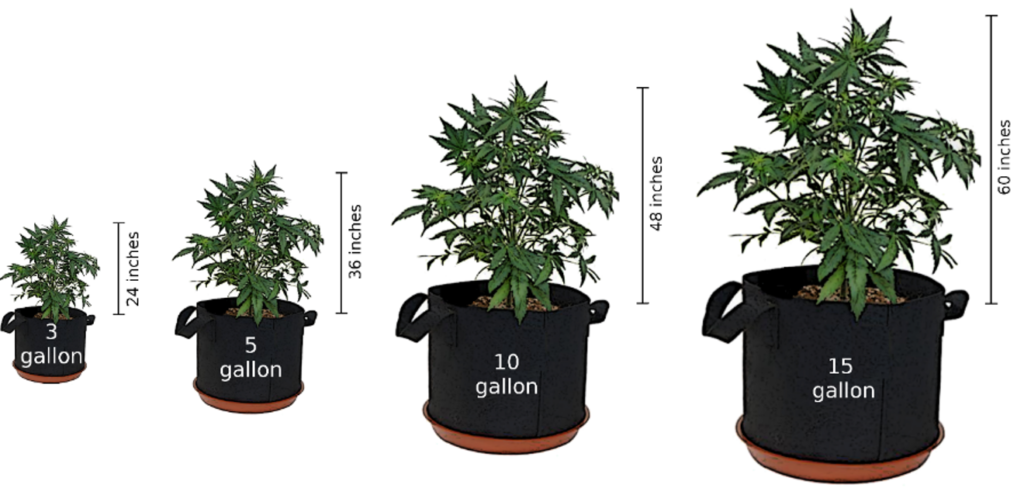
As a rule of thumb, you should add around 5 gallons (19 liters) of plant container space for every 12 inches of growth. So if you’re growing cannabis in 3 gallon pots, induce flowering or transplant when the plant is 2 feet tall. However, that idea might lead to a really big pot grow. Sativas can grow as high as 25 feet! You need a large container for a sativa that can grow huge! Cannabis plants need enough space for their roots to spread and the plant to thrive and have enough room to grow.
Keep in mind that moving to new containers is stressful. Your cannabis plants will do better if you move them directly to the container they’ll need until harvest. They can stay in that container for the rest of the grow cycle. Give them room to grow and they will thank you for it later.
Best Grow Pots for Weed Plants
So many different cannabis pots are available for growing weed! The best pot material for growing weed depends on the grow system and soil that you’re using. That said, don’t opt for materials like metal, clay, or terracotta. You’re better off with fabric pots that have more airflow when you plant pot.
Here are some of the best pots we recommend for growing marijuana. These different types of containers will work in your budget! You can use small pots for small cannabis plants, and larger pots for large plants.
Smart Pots
If your plants grow in soil (or in a soil-like growing medium like peat moss with perlite), your set up is well suited for Smart Pots. Smart Pots are some of the most commonly used pots for growing cannabis.
Smart Pots are made of a porous fabric material. Fabric pots have better gas exchange than plastic cannabis containers. When the plant’s roots get to the edges of a Smart Pot, they stop elongating and grow fine lateral roots that enhance gas exchange. This prevents your plants from becoming root bound.
Other factors make Smart Pots a good choice. A Smart Pot provides great aeration, which enhances the health of the rhizosphere. Smart Pots dry quickly and are light weight.
Smart pots are the most commonly used pots for cannabis. Their only disadvantage is that they do not have rigid sides. Take care when moving Smart Pots!
What size smart pot for indoor grow? A 3 to 5 gallon Smart Pot will be perfect! What about a Smart Pot outdoor grow? Outdoor growers can use very large Smart Pots. Indoor growers can use small pots or larger pots depending on the room you have and ceiling or tent height.
Superoots Air-Pot
Don’t want a fabric pot? Super Roots Air Pots are excellent plastic containers. They’re good for hydroponic systems that aren’t constantly filled with water and for root growth.
Air-Pots encourage the roots to follow the nutrient solution to the edges of the plastic container. This allows beneficial bacteria to release all the nutrients. When the tips reach oxygen, they dehydrate and split, creating new tips. This is known as air pruning.
Greater nutrient absorption happens at these points. This encourages the plants to grow. Air Pots are also very sturdy.
Grodan Rockwool Blocks
Grodan grow cubes are rockwool, an inorganic grow medium made from basalt and chalk. The pores in rockwool facilitate the roots getting oxygen. Its massive capillary action makes it a great growing medium for hydroponic and aeroponic systems.
Grodan’s rockwool cubes have advantages over other rockwool products. They can be planted into each other. This makes transplanting very easy. Simply place the Grodan cube in a larger-sized cube and the transplant is finished!
Container Construction Material
Containers and pots intended for plants are constructed out a variety of materials, including terracotta, coir (coconut husk), plastic, ceramic, metal, wood, concrete, and rubber. The most economical, sturdy, and damage-resistant of these would be rubber or coir.
Rubber and plastic are probably the most widely used in nurseries and plants purchased for re-potting. A rubber plant container of the appropriate size makes a lot for sense for cannabis use. Many containers will shatter or chip with rough handling, but rubber bounces back and keeps performing for multiple grows.
Since nurseries rely on them so often, rubber pots almost always have adequate drainage and are able to retain moisture well.
Many cannabis growers have their personal favorite when it comes to cultivating cannabis, and compelling arguments can be made for each container medium, but there is much to be said for rubber or durable plastic, and these are the materials used most often. Having holes in the bottom can help with drainage.
Growing Media for Cannabis
Growing cannabis plants in pots requires growing media. Straight potting soil is the simplest, most widely available choice. If you have access to compost, this is an excellent way to grow organically by adding it to soil for a nutrient-rich growing medium.
A variety of premixed soils with fertilizers already added are widely available as well. Some of these are organic, while others contain synthetic additives. The vast majority of cannabis growers prefer organic media.
Other materials sometimes added to soil include sand, perlite, and coco fiber. These substances provide a less-dense soil mixture than straight soil.
This type of mixture promotes rapid root development, which is always good for a cannabis plant’s overall health. Avoid soils that contain clay or other dense matter.
They will clog root development and retain too much water, neither of which is good for cannabis. Root growth is majorly important when growing marijuana and the grow media is important to assure proper root growth.
Regardless of which pots you choose for your cannabis cultivation, be sure to follow best practices and monitor your grow carefully. With attentive care, you can produce excellent flower with most pots. Use quality genetics, provide good care, and you will enjoy the rewards of your harvest on a relatively short amount of time!
How big should cannabis pot be?
It depends on the strain and the goal of the desired outcome. When picking a container each pot size will be determined by the desired final size of the plant. Use a container 5-gallons or larger to stop the roots from becoming root bound for strains that are kept in the vegetative phase for 6 weeks or longer.
Does pot size affect cannabis yield?
Yes pot size will affect cannabis yield. A bigger pot will result in bigger yields. Cannabis grows long roots that need ample room to reach their ideal outcome. Growing cannabis in a container that is too small will lead to root bound and stunt the plants growth.
How much cannabis can you yield in a 5 gallon pot?
If growing Indoors, under 1000-watt HPS lights, with an average of 4-weeks of vegetative time in a 5-gallon buckets, the plant yield should be approximately one quarter of a pound (112 grams) of dry cannabis flowers per plant if all other factors are set up correctly. This of course also depends on the strain chosen.
What happens if a pot is too big when growing cannabis?
Soil dries slowly in too large of pots which will make the plants more susceptible to root rot. Too large of pots also tend to tip over easily in wind.
Does bigger pots mean bigger plants?
Yes. Doubling plant pot size makes plants grow over 40 percent larger on average.
How big can a cannabis plant grow in a 3 gallon pot?
Ideally, cannabis plants should have 5 gallons (19 liters) of plant container space for every 12 inches of growth. If cultivating cannabis in 3 gallon pots, switch the plants to flowering phase (12 hours of darkness, 12 hours of light) or transplant when the plant is 2 feet tall.
When should I increase my pot size?
Some common signs that a cannabis plant needs more space are:
-Roots busting out the bottom of the pot
-Soil level has dropped or appears dry and hardened
How much does an average cannabis plant yield indoors?
The average yield per cannabis plant grown indoors using 600W – 1000W lights is
150 to 300 grams (up to 600 grams for more experienced growers). And an average of 250 to 500 grams (1000 grams for more experienced cannabis growers) with a 1000-watt HPS light.
Why are fabric pots better?
Fabric pots allow extra oxygen to make it to the plant roots from all sides, not just from the top, which helps soil to thrive.
Why does pot size matter while cultivating cannabis?
The size of the pot matters because it dictates how much space the roots have to spread out. Greater root development in larger pots might result in a healthier and more fruitful plant. On the other hand, too-small pots can impede root development and cause problems including stunted growth and nutrient shortages.
How big of a pot should a cannabis seedling have?
Smaller pots (about 1-2 liters or 0.25-0.5 gallons) work best for seedlings. In preparation for transplanting, this helps sustain proper moisture levels and promotes a robust root system.
“
There are over 300,000 jobs in the cannabis industry. CTU trained me for one of them!

Makes $24.50 @ THC +
When is the right time to move my cannabis plant into a bigger pot?
The plant has to be transplanted when its roots completely fill the pot; this is frequently apparent when roots begin to show through the drainage holes. Usually, a few weeks have passed since germination.
Is it possible for a cannabis plant to outgrow a pot?
Sure, too big of a pot can retain too much moisture, which can cause root rot. As the plant grows, it's recommended to gradually increase container size.
How big of a pot should a mature cannabis plant have?
Five to ten gallon pots are typically used for a fully established indoor cannabis plant. Plants can grow in even bigger pots outside—up to 15 gallons or more—depending on the type and growth environment.
Is there a relationship between pot size and cannabis yield?
In general, a larger pot gives more room for roots, which means that a larger plant may be supported and perhaps yield more. However, other elements like diet, lighting, and heredity all affect the final output.
Are cloth pots for cannabis preferable to plastic pots?
The benefits of fabric pots include better drainage and increased air circulation to the roots, both of which help promote healthier root systems. Although plastic pots are more resilient and hold moisture longer, they can cause problems such as poor drainage and overheating.
How frequently should I water different pot sizes of cannabis?
Smaller pots may need to be watered more frequently since they dry out more quickly. Larger pots hold moisture longer, allowing for less regular watering. It's important to monitor soil moisture levels and apply water when the top inch of soil appears dry.
Do various cannabis strains call for various sizes of pots?
While smaller indica strains can frequently be cultivated in smaller pots, larger sativa kinds, marijuana particular, may benefit from larger pots to match their potential growth.
For cannabis plants, how deep should the pot be?
For most cannabis plants, the suggested depth is at least 10 to 12 inches. This depth offers sufficient soil to hold moisture and nutrients while promoting proper root development.
The Right Weed Plant Pot Size
Strive for balance. While you don’t want to stunt growth with a small pot, an excessively large pot might result in overwatering. Ensure good drainage and consider the grow medium volume when deciding on pot size.
Master Grower Certification Online
Are you ready to get started on a career as a cannabis grower? Cannabis Training University will help you do it without being illegal! Want to get growing cannabis for a living or just for your own personal home grow? Want to plant pot in a small space in your home and stop paying for it at dispensaries?
One plant or many plants, we teach how to grow pot plants in an easy step-by-step fashion. Learn how at CTU, the internationally accredited cannabis college!
Check out CTU’s Master of Cannabis Certification Program. Put it in your cart today and start your master grower job soon. CTU is the most popular cannabis school in many countries.

Luis Cordova
Luis Cordova is a distinguished author, and renowned expert in cannabis cultivation, who possesses a Master's degree in Plant Biotechnology and Pharmaceutical Science. As a valued contributor to highly esteemed publications such as Cannabis Training University and Maximum Yield Magazine, Luis has emerged as a trusted source of guidance and knowledge in the cannabis industry. Having written thousands of informative articles, Luis is widely recognized for his comprehensive expertise on cultivating cannabis, both indoors and outdoors.


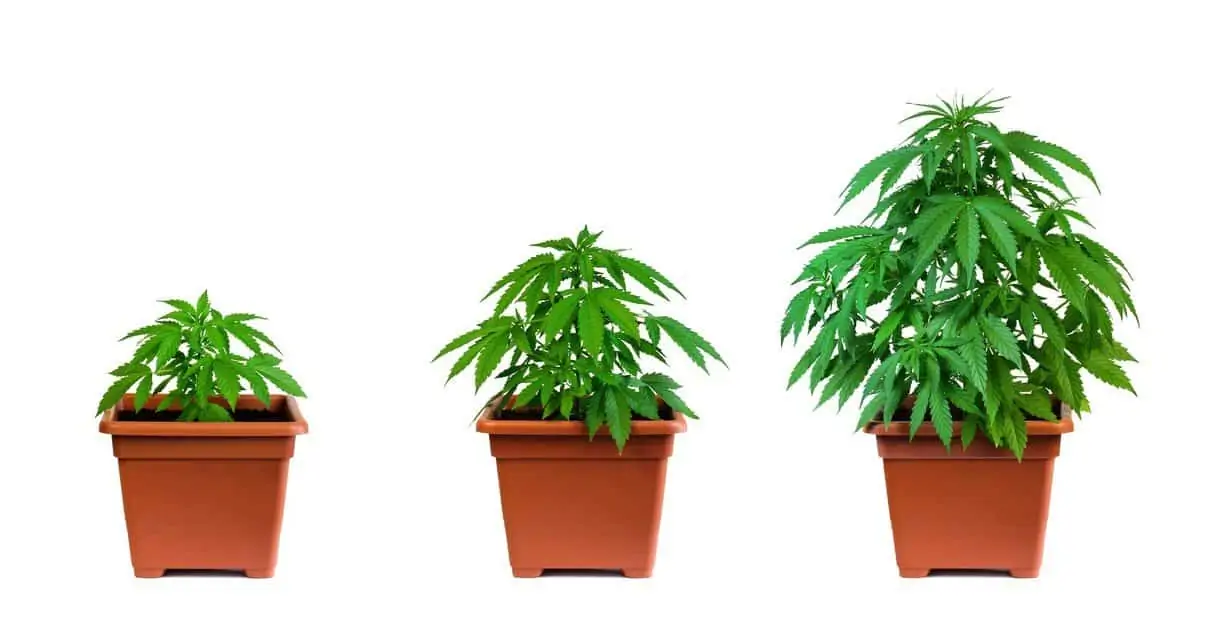
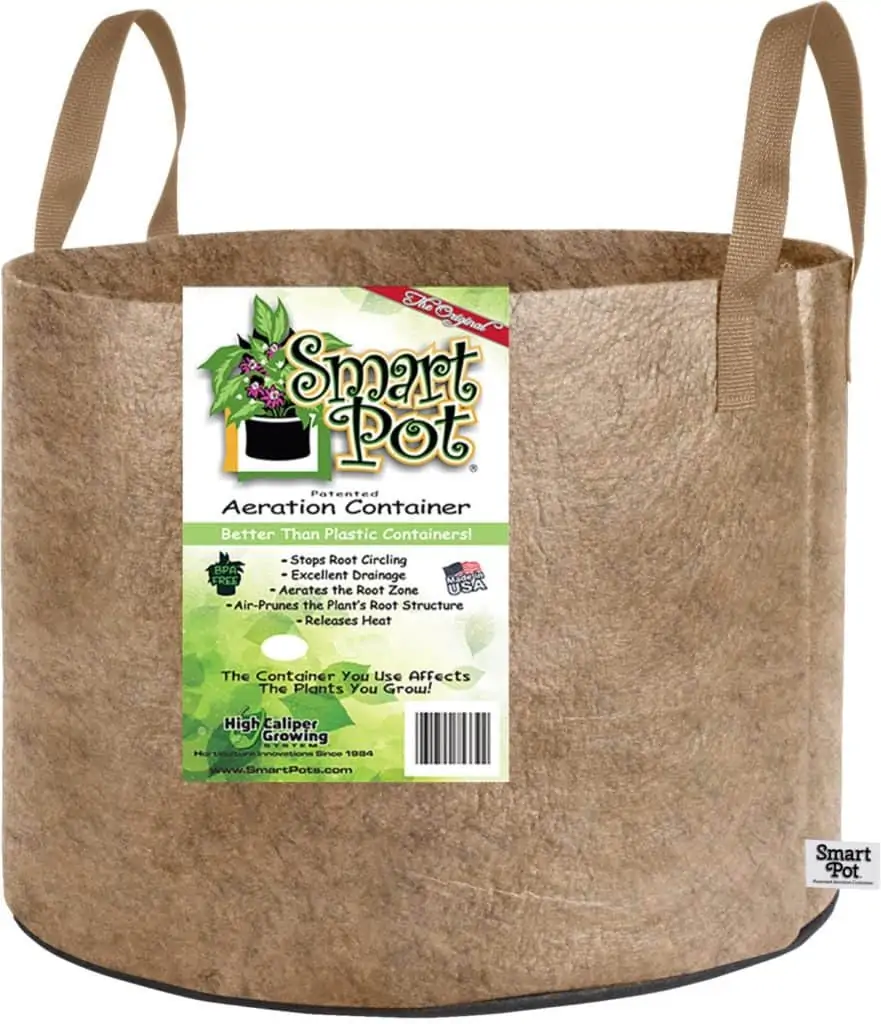
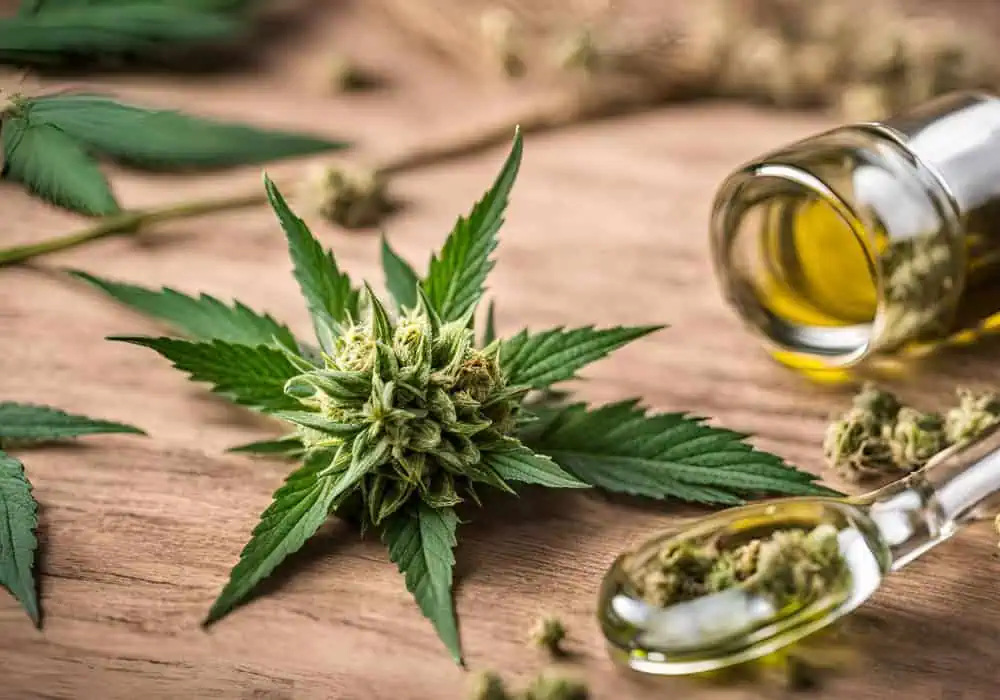


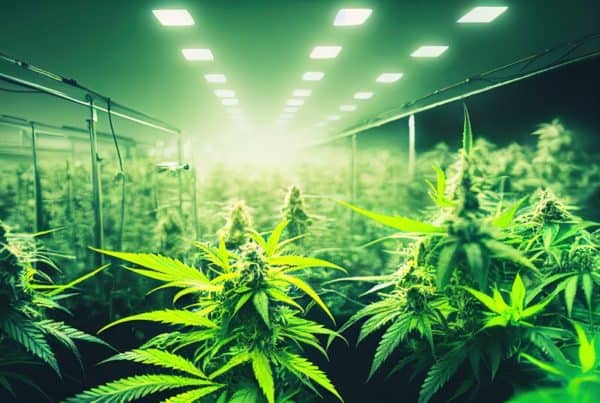
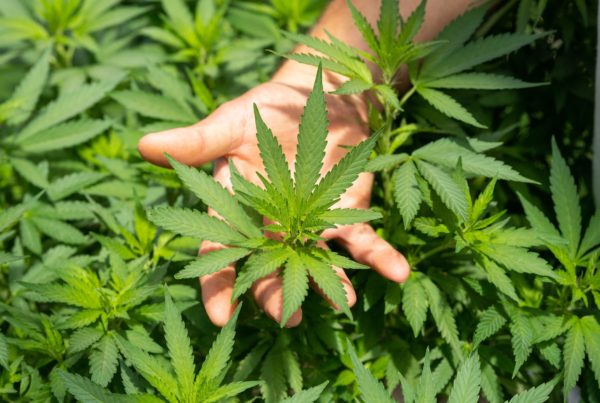
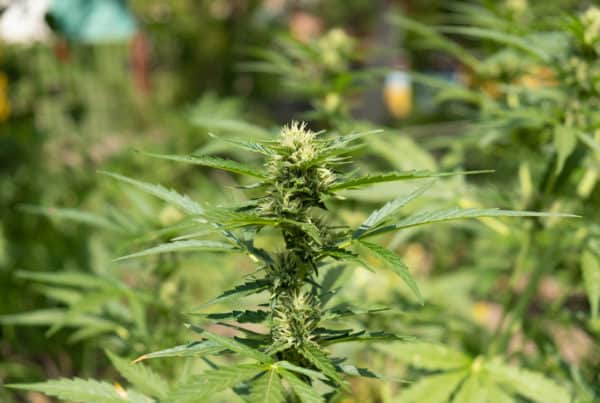



 Jeff was involved in an accident where he endured a traumatic brain injury. He had a week-long stay in ICU where brain surgeons
Jeff was involved in an accident where he endured a traumatic brain injury. He had a week-long stay in ICU where brain surgeons  100% risk free money back guarantee within 48 hours after purchase if student has not completed any of the courses or exams.
100% risk free money back guarantee within 48 hours after purchase if student has not completed any of the courses or exams.